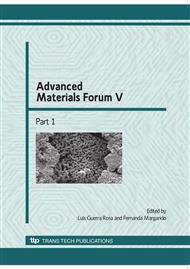[1]
K. Otsuka and X.B. Ren: Intermetallics Vol. 7 (1999), p.511.
Google Scholar
[2]
M. Igharo and J.V. Wood: Powder Metall Vol. 28 (1985), p.131.
Google Scholar
[3]
M. Whitney, S.F. Corbin and R.B. Gorbet: Acta Mater Vol 56 (2007), p.559.
Google Scholar
[4]
C. Zanotti, P. Giuliani, A. Terrosu, S. Gennari and F. Maglia: Intermetallics Vol 15 (2007), p.404.
DOI: 10.1016/j.intermet.2006.08.002
Google Scholar
[5]
A. Biswas, Acta Mater Vol 53 (2005), p.1415.
Google Scholar
[6]
B. Yuan, C.Y. Chung and M. Zhu, Mater Sci Eng A Vol. 382 (2004), p.181.
Google Scholar
[7]
M. Bram, A. Ahmad-Khanlou, A. Heckmann, B. Fuchs, H.P. Buchkremer and D. Stöver: Mater Sci Eng A Vol. 337 (2002), p.254.
DOI: 10.1016/s0921-5093(02)00028-x
Google Scholar
[8]
A.M. Locci, R. Orrù, G. Cao and Z.A. Munir: Intermetallics Vol. 11 (2003), p.555.
Google Scholar
[9]
F. Neves, A. Cunha, I. Martins, J.B. Correia, M. Oliveira and E. Gaffet: Microsc Microanal Vol. 14 (S3) (2008), p.13.
DOI: 10.1017/s1431927608089241
Google Scholar
[10]
F. Neves, A. Cunha, I. Martins, J.B. Correia, M. Oliveira and E. Gaffet: Mater Sci Forum Vol. 587-588 (2008), p.625.
Google Scholar
[11]
F. Neves, I. Martins, J.B. Correia, M. Oliveira and E. Gaffet: Mater Sci Eng A Vol 473 (2008), p.336.
Google Scholar
[12]
F. Neves, I. Martins, J.B. Correia, M. Oliveira and E. Gaffet: Intermetallics Vol 15 (2007), p.1623.
Google Scholar
[13]
F. Neves, I. Martins, J.B. Correia, M. Oliveira and E. Gaffet: Intermetallics Vol 16 (2008), p.889.
Google Scholar
[14]
R. Valiev: Nat Mater Vol. 3 (2004), p.511.
Google Scholar
[15]
S. Suryanarayana: Prog Mater Sci Vol. 46 (2001), p.1.
Google Scholar
[16]
L.L. Ye, Z.G. Liu, K. Raviprasad, M.X. Quan, M. Umemoto and Z.Q. Hu: Mater Sci Eng A Vol 241 (1998), p.290.
Google Scholar
[17]
Y.W. Gu, C.W. Goh, L.S. Goi, C.S. Lim, A.E.W. Jarfors, B.Y. Tay and M.S. Yon: Mater Sci Eng A Vol. 392 (2005), p.222.
Google Scholar
[18]
A. Takasaki: Phys Stat Sol Vol. 169 (1998), p.183.
Google Scholar
[19]
T. Mousavi, M.H. Abbasi and F. Karimzadeh: Mater Lett Vol. 63 (2008), p.786.
Google Scholar
[20]
Shape Memory Alloys, edited by Hiroyasu Funakubo, volume 1 of Precision Machinery and Robotics, chapter, 2, Gordon and Breach Science Publishers (1987).
Google Scholar


